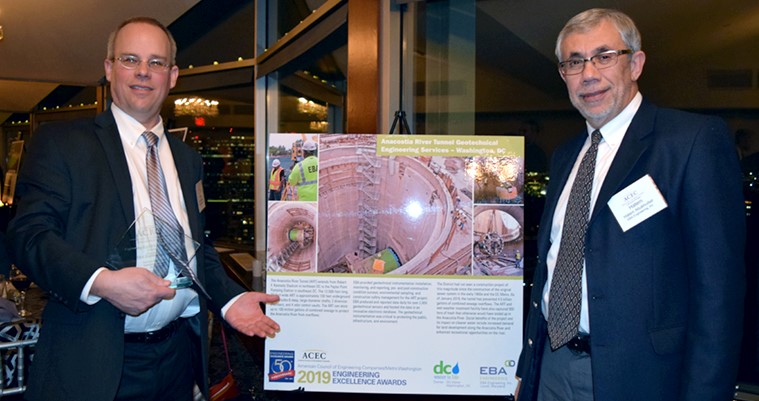Anacostia River Tunnel Geotechnical Project Receives ACEC/MW Excellence Award

The Anacostia River Tunnel (ART) Geotechnical Engineering Services project has received an Honor Award in the American Council of Engineering Companies of Metropolitan Washington (ACEC/MW) 2019 Engineering Excellence Awards competition. EBA’s Rizwan Siddiqi, Jason Kolenda, and Hatem Abukhudair accepted the award at an awards gala on January 23, 2019, in Arlington, Virginia.
ACEC’s annual Engineering Excellence Awards competition recognizes engineering firms for projects that demonstrate an exceptional degree of innovation, complexity, achievement, and value.
“This project required extremely meticulous and detailed data collection 24/7 on a very large project area, as well as constant monitoring to ensure safety and prevent structural failure,” said EBA President and CEO Rizwan Siddiqi, PE. “We’re proud of the entire team and honored by this recognition.”
EBA provided geotechnical instrumentation installation, monitoring, and reporting; pre- and post-construction condition surveys; environmental sampling; and construction safety management for the ART project.
EBA collected and reported data daily for over 2,000 geotechnical sensors and hosted the data in an innovative electronic database. The geotechnical instrumentation was critical to protecting the public, infrastructure, and environment.
The ART extends from Robert F. Kennedy Stadium in northeast DC to the Poplar Point Pumping Station in southeast DC. The 12,500-foot-long, 23-foot-wide ART is approximately 100 feet underground and includes 6 deep, large-diameter shafts; 2 diversion chambers; and 4 odor control vaults.
The ART can store up to 100 million gallons of combined storm and sanitary sewage to protect the Anacostia River from overflows. As of January 2019, the tunnel has prevented 4.5 billion gallons of combined sewage from entering the river.
The ART and wet weather treatment facility have also captured 900 tons of trash that otherwise would have ended up in the Anacostia River.
Social benefits of the project and its impact on cleaner water include increased demand for land development along the Anacostia River and enhanced recreational opportunities on the river.
The District of Columbia Water and Sewer Authority (DC Water) had not seen a construction project of this magnitude since the construction of the original sewer system in the early 1900s and the DC Metro.
DC Water is responsible for treating wastewater for more than 2 million residents in the District of Columbia and adjacent counties.
